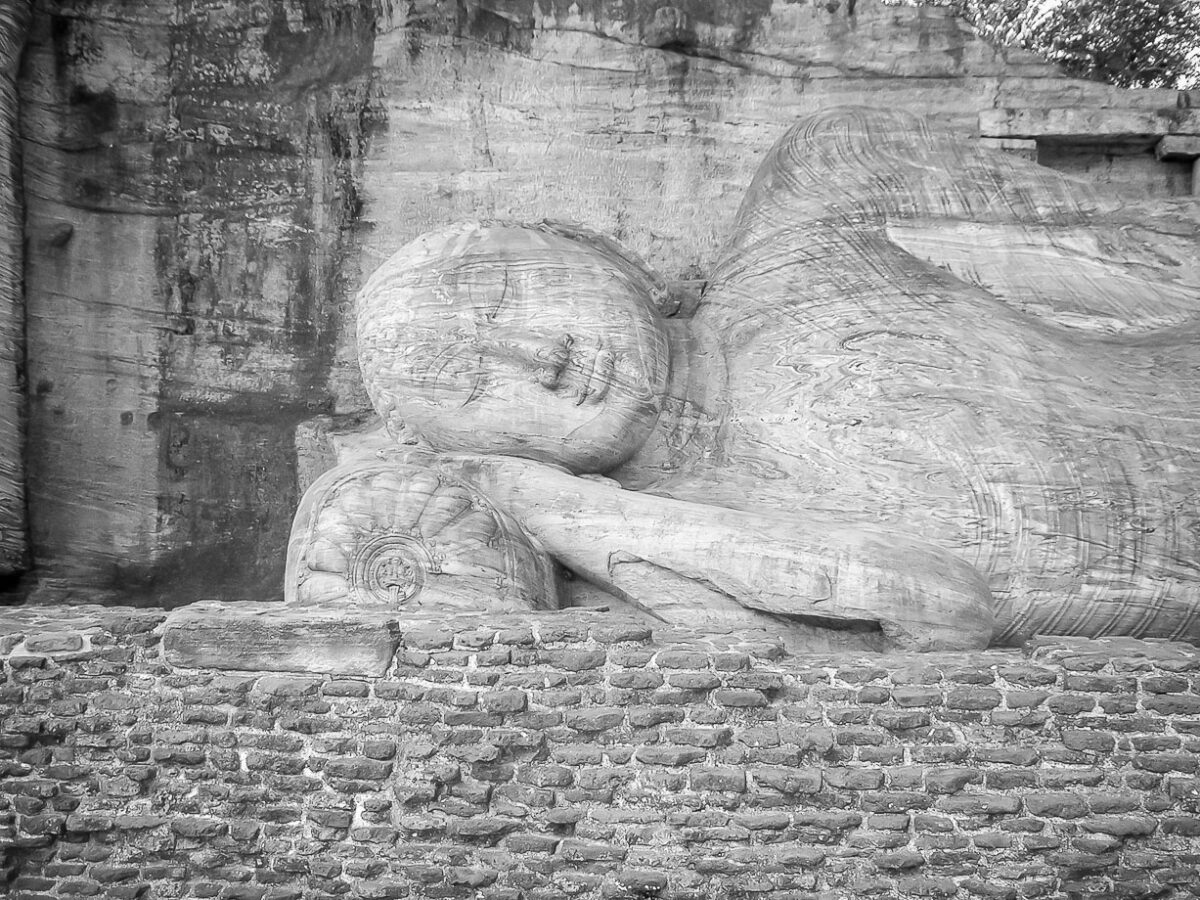I was living in London with my sister, Lisa. Lisa had an idea for us to take a holiday in Sri Lanka over Christmas in 2005. Usually, we would spend Christmas in London together. Eat some comfort food and then I would drive us in my car through the center of London to see the Christmas Lights. Christmas Day in London was the only day of the year when absolutely everything is shut and the inner city is deserted because people are all at home having their Christmas dinners.
Anyway although I was up for a change of plan this Christmas, when I saw the price of airfares and accommodation, which was double the price, I suddenly went off the idea of a Sri Lankan Christmas. So, we decided to go in January instead. Thank God we did as Sri Lanka was devastated by the 2005 Tsunami on boxing day (25 December)!
To go or not to go
The agency through which we had booked offered us some options – keep the booking, postpone or get a full refund. We would also get a significant discount on the fancy hotel Lisa had decided we would stay in.
There was a lot of debate in the media at the time and opinion was split on whether to go or not. The first camp supported a return to tourism as soon as possible to start sending money back into the communities, which depend on tourish. The second camp was against the concept of “disaster tourism” or profiting from other people’s misfortunate by objectifying them as objects or a tourist’s amusement. Even if you did not see the moral argument, why even go there because all the tourist infrastructure will have been destroyed, people will be living in tents and it will just be a horrible and unpleasant experience.
After carefully weighing up the options, we decided to go. But a month later in February, to give the locals some opportunity to rebuild tourist infrastructure.
A tale of two halves
The epicenter of the Tsunami was off the north west coast of the Indonesian island of Sumatra. You can read here about my visit to Sumatra in 2006 witnessing some of the devastation first hand. The earthquake created a tidal wave which crossed 1700km from Sumatra to Sri Lanka across the Indian Ocean. Worst hit was the East Coast, but the wave continued along the south and then refracted up the west coast, hitting the main railway line and highway.
Lisa had planned anyway for us to stay in this fancy hotel in the so-called “Cultural Triangle” – an inland tourist attraction featuring ruins of ancient kingdoms and religious monuments. The towns making up the Cultural Triangle are all inland and were not affected directly by the Tsunami. We planned to stay one week there, then Lisa would fly back to London and I would travel on alone to Kandy in the centre of the country, then down to the beaches of the south coast.
So, this trip was in two completely different parts. One in a very isolated and priveleged location far away from local life. The second, on the road, travelling as a backpacker in packed vans and staying in cheap guesthouses.
Part One – The Cultural Triangle
Dambulla
Dambulla is a town in centre of Sri Lanka. We used it as a base to explore the Cultural Triangle. The town itself is a complete dump with nothing to recommend it. The main tourist attractions outside of the town are a giant Buddha and some ancient caves with temples.
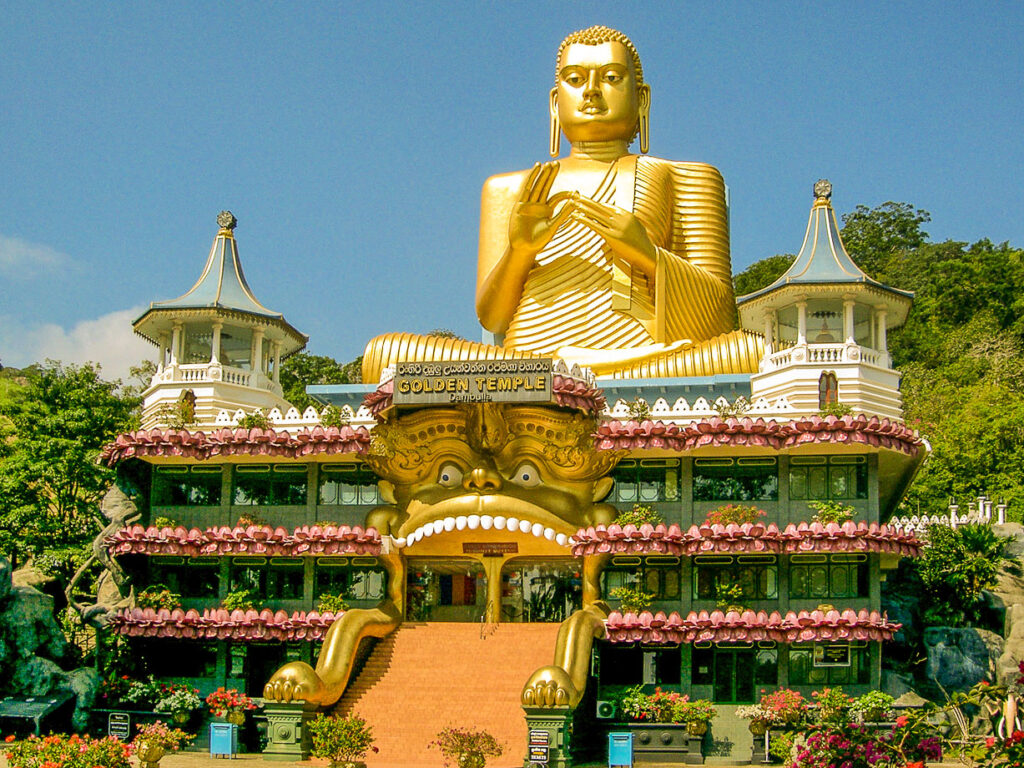
Lisa had selected a hotel for us to stay near Dambulla. The Kandalama hotel is regarded as one of the top hotels in Sri Lanka and we paid a pittance to stay there. It’s in an exclusive location in the jungle with views of a nearby reservoir. There are 3 swimming pools including an infinity pool. We practically had the place to ourselves. We estimated there were at least 3 staff for every guest. The staff had nothing to do all day, so were overly attentive. They were just trying their best to look busy, but it became a bit overbearing at times.
The hotel would be perfect for a romantic getaway or honeymoon, but I found it boring and sterile. I yearned to get out and experience the real country. It had a real 1970s museum feel to it. To be fair, the hotel has since undergone a complete renovation.
By far the best feature of the hotel was the incredible food. Every night there was an extensive buffet for the price of a sandwich in Europe. One night, there was a curry special. I have travelled all over Asia and thought I had tried every single curry there is. Well, this was the most amazing selection of the most incredible curries I have ever had the pleasure of feasting upon. Every possible kind of meat, fish and vegetable with spices of every colour of the rainbow were on offer. There were even dessert curries made from fruit, like jackfruit.
Sigiriya
One of the top attractions in the Cultural Triangle is the ruins of the ancient kingdom of Sigiriya. Sigiriya is basically a huge rock which you can climb. The rock was once the ancient capital of a Sri Lankan king in the 5th century. He built a fortress on top and added frescoes on the way up. Half way up, he added a large gate in the form of a lion, this giving the place its name, which means “lion’s rock”. Legend has it that he kept elephants in the palace and used to have them fight each other for his amusement!
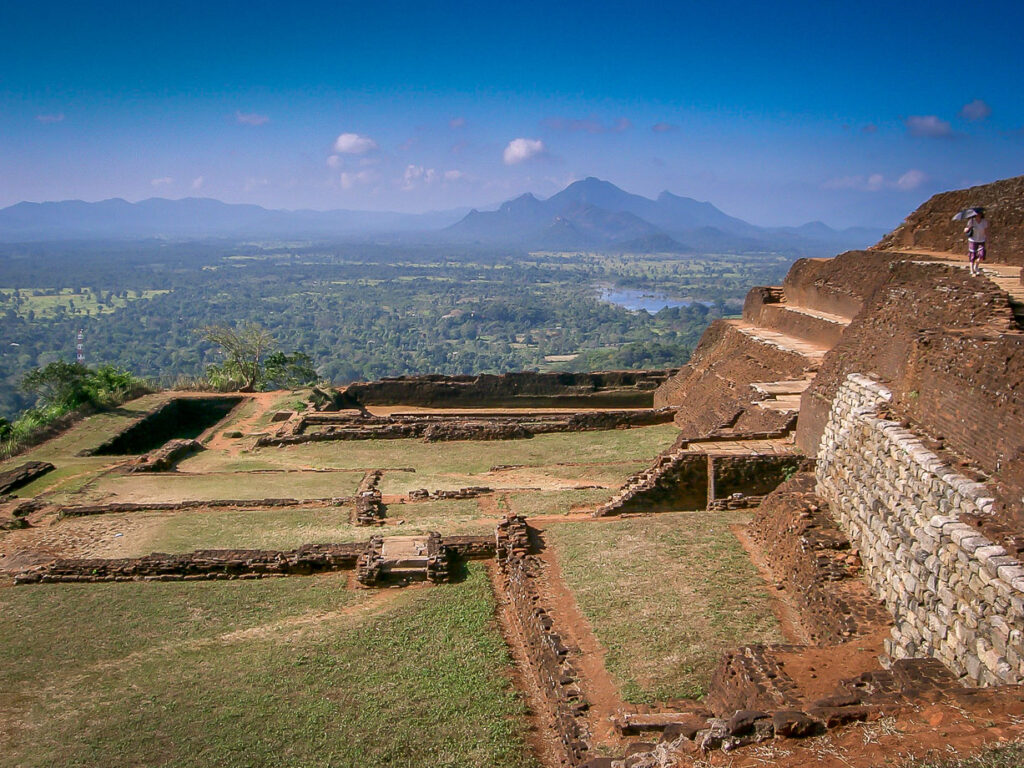
Polonnaruwa
Polonnaruwa is another ancient kingdom of Sri Lanka established in the 11th century. It is one of the best preserved archeological sites in the country. You can see the remains of ancient buddhist temples and stupas (mound-like structures containing Buddhist relics).
Another ancient city with similar ruins is Anuradhapura, featuring large white stupas. We decided to skip it feeling we had had our fill of Buddhist monuments in Polonnaruwa.
Part 2 – On the road to the Tsunami-hit region
Kandy
At this point, I bade farewell to Lisa and continued the journey alone. I stood on the side of the road and eventually a mini-van stopped carrying local passengers. The other passengers were incredibly friendly. Sri Lanka is often referred to as “India light” meaning it is very similar to India in terms of culture, food, geography, climate, etc, but is much easier to travel around, the people are much friendlier and although still being a poor country, the population is well educated with high literacy rates compared to its larger neighbour.
Kandy is a city located at the bottom of the Cultural Triangle. It is considered a holy city and has a famous temple on a lake, the Temple of the Tooth, one of the most important Buddhist sites in the world. It houses an actual tooth of the Buddha, the founder of Buddhism.
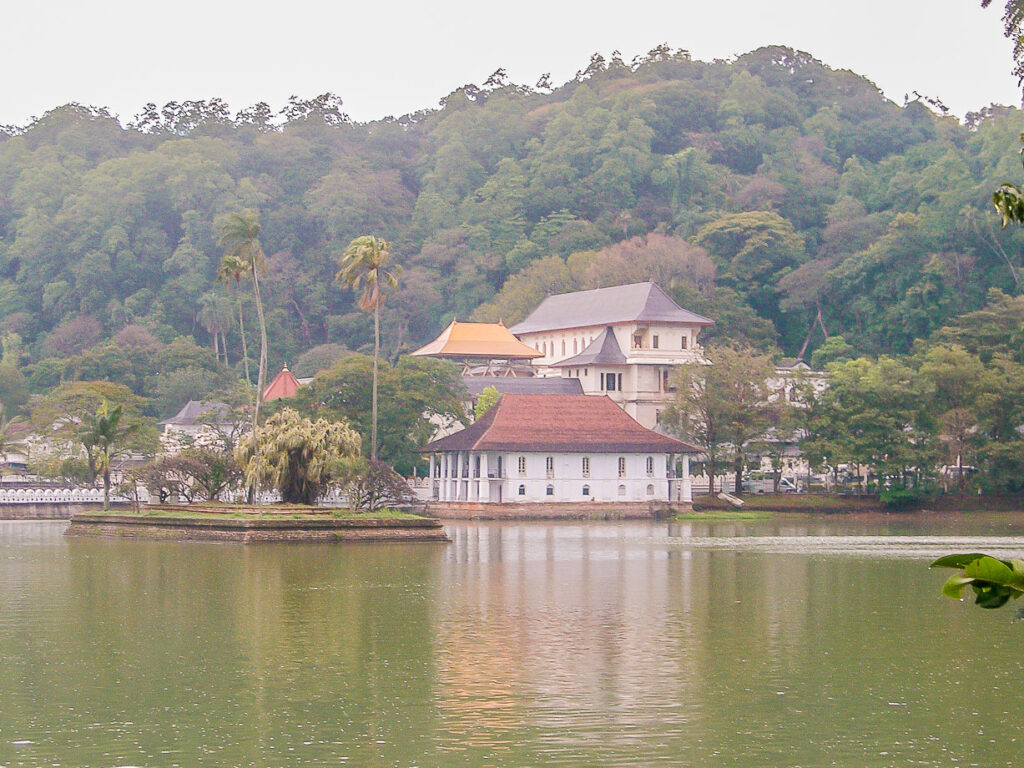
Otherwise Kandy is quite a pleasant place to hang out for a few days. I happened to be staying at a guest house with a famous local guide who took me and a group hiking for 2 days in the jungle bird watching.
At the same guest house, I met a family from Canada. The parents had taken a sabbatical and were travelling around the world with their 2 kids. The parents were obviously ex-hippies, so were probably quite chilled in the first place, but I couldn’t get over how chilled the 2 kids were. For breakfast at a typical Sri Lankan guest house you have a choice of western (eggs and bread) or local (spicy fried noodles). The kids were chowing down on the local breakfast as if it were nothing. Giving the kids exposure to different cultural practices had broadened their horizons to the point where eating a local breakfast had become normal. Imagine the same kids back home fighting and arguing over which flavour of corn flakes they would have for breakfast. After seeing this, I swore that if I ever had kids, I would take them on a world trip like the one these parents were doing. They would learn more about the world and life in general on that year than 10 years in school. Alas, it never happened (having kids, I mean), so instead I just pass on my knowledge in this blog.
The West coast to the southern beaches
At this point I was still undecided about whether to travel to the part of the country impacted by the tsunami. Would there even be anywhere open to stay there? If I had just wanted beach, I could have travelled back to Colombo and stayed at one of the nearby beaches. But I had heard bad things about these beaches and the guide at my guesthouse in Kandy convinced me to head south.
This time, I decided to hire a car and driver to take me to Galle, a city on the south coast of Sri Lanka. The road followed the west coast of the island. The main railway line ran parallel to the main highway. As we arrived in the tsunami hit areas, I was shocked by the devastation. Many villages had been completely distroyed or only shells of houses were left. It looked like a war zone. There were many people living in tents. At one point, I stopped to take some photos – the guide in Kandy had asked me to take some and send them to him – but I still felt bad, like I was exploiting there misfortunate for my own amusement.

The most shocking site was carriages from a train which had been picked up by the tsunami and rolled 500 metres inland! I could not imagine the power of something that could do that! The tsunami had hit in the morning just as commuters were travelling to work. This train wreck caused 1700 deaths – the single largest train disaster in history!
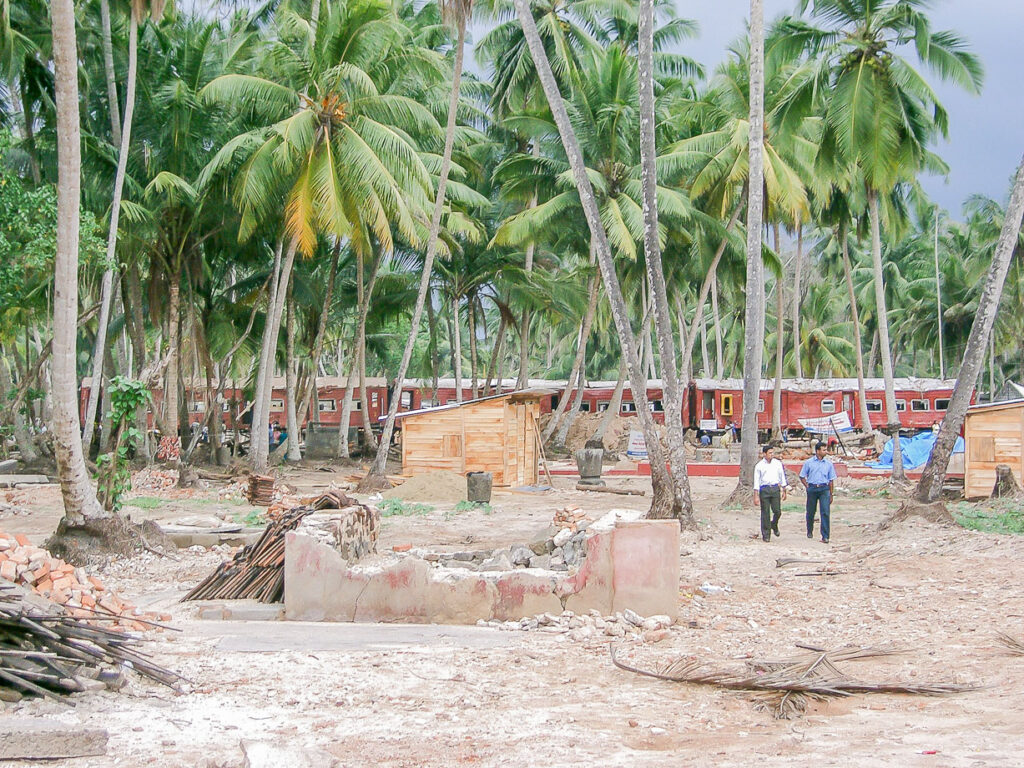
Galle
Galle is a city in the south of Sri Lanka. I only knew of Galle as it is a venue for international cricket matches between New Zealand and Sri Lanka. It was a small port town until the arrival of the portuguese in 16th century. They developed it into a fort, the walls of which remain to this day.
While strolling around the fort one evening, a local couple approached me. They were super friendly and invited me to their house for dinner. The house was a bit out of the way and I was taking a bit of a risk, but hey, no risk, no reward. When I arrived, they had invited the whole extended family and prepared a massive feast for me, as guest of honor! They were such kind and generous people.
You hear horror stories of tourists falling victim to scams when responding to invitations to visit the homes of some seemingly friendly locals only to end up being drugged or robbed. Some times you just have to trust your intuition and go for it. You have to understand that in many “third world” countries, the people have very little contact with outsiders and are fascinated to meet you and learn about your culture. They are also very happy you chose to visit their country and they want you to experience their local lifestyle and the generosity of their culture. Of course, the easier option is just to ignore such overtures, stick to the beaten path and hang out only with other tourists. But then the only locals you meet are the ones serving you in bars and restaurants and you miss out on these priceless experiences, which is the whole point of travelling in my opinion.
Unawatuna beach
Near Galle is one of Sri Lanka’s best beach resorts, Unawatuna. Now, when I saw resort, in 2005 it was more of a backpacker hangout. A couple of the guesthouses on the beach had already been completely rebuilt. I and another Dutch guy were the only tourists. There were very few people there – the beach was practically deserted. The only other foreigners were working for NGOs. There were no local tourists.
Any lingering doubts I had had about going there were quickly dissipated. The people were so, so happy to see me. I spent really lavishly and tipped very generously. It was heartbreaking though. In the evening I would be walking along through the jungle somewhere and someone would appear in the dark suddenly from behind a tree begging for money or food. Many of these people had completely lost their livelihood and means to earn a living. One guy had lost his boat, another guy his guesthouse which had been destroyed. This guy showed me a photo of him standing outside his guesthouse with his 2 brothers who were lost in the tsunami. He had been away on an errand that day and only his wife and small child had survived as their house was quite a distance from the beach. I agreed to help him – I bought some stuff I didn’t need and gave him a small amount of money (5 GBP) – nothing by UK standards, but a large amount of money by local ones.

Amazing survival stories
I got talking to the guys working at my guesthouse. They survived and had the scars to prove it. They told me how it happened. Suddenly there was this freak huge wave which came all the way up the beach and reached the guesthouse. All the guesthouses had chill out areas with hammocks, bean bags and cushions. These items got washed out to sea by the wave. So, the managers told the staff to go out and retrieve the items which were washed up. But something was not right. This freak wave kept retreating and retreating beyond the shoreline and for miles out to sea. What they hadn’t realised was, that wave was just a taster of what was to come. They heard a deep rumbling sound in the distance and then they saw it – a 5 storey high wave heading in their direction! They ran as fast as possible but they were too far out to sea and the wave was too fast. Luckily they survived to tell the tale, but many received broken bones and cuts.
One guy said to me – we are happy to be alive. Now, we just want to rebuild our lives and get on with it. Without complaining or feeling any self-pity. But they warned me. They said many of the people begging for money were not even from there! They had moved to the area after the tsunami to prey on the emotions of tourists and scam them! Then, he pointed to someone on the beach trying to sell jewelry to the only other couple there. He said, that guy for example! It was the same guy who had told me the (fake) story about his guesthouse!
Incredible stories of generosity
I got talking to the Dutch guy at my place. It turned out he had been going there on holiday every year for the last 20 years. Before coming out, he had asked all his friends and family to pitch in to make a private fund. He told me how he was helping out some of the local people. He said he never gave money directly, instead prefering to invest it on behalf of needs locals. For example, he told me he had given 300 € to a family to rebuild their shop. I was taking all of this with a bit of a grain of salt – how could I know if he was genuine or just bragging or virtue signaling? Then, we saw a figure walking along the beach in the distance. As he gradually got closer, I could make out he was a gaunt old man with a basket on his head. The Dutch guy said, his business is selling peanuts and postcards. He lost his basket and all his inventory in the tsunami. I bought him a new basket and postcards. I was still thinking this guy might be full of shit, but then the man approached us – he looked at me while pointing to the Dutch guy – he was shaking with emotion and holding back the tears. He said in broken English – “This man, good man.” This Dutch guy had literally saved his life by giving him the means to keep his business alive and hence money to buy food.
Epilogue
Sometimes your life takes some strange turns. Had we been on the beach in Sri Lanka on boxing day of 2004, it might have turned out quite differently. Sri Lanka is a great country. Tons of history, some beautiful nature and super friendly people. The economic situation has not been that great of late, but don’t let that deter you – the people will need your tourist dollar now more than ever.
Witnessing the devastation of the tsunami first hand here and a year later in Sumatra was a humbling experience. It was shocking to see the power and devastation wrought by mother nature. Then to see the determination and perserverance of the people despite having suffered severe hardship and adversity. I will never forget that experience.
